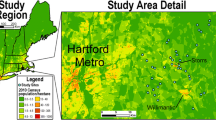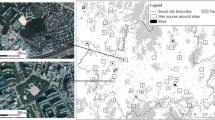Abstract
Forested wetlands in metropolitan areas function to support biodiversity, protect water quality, store floodwaters, and maintain streamflow, but they also function to provide natural areas for passive recreation, education, and esthetic appreciation for the surrounding human populations. However, the presence of dense human populations in the watersheds of wetlands is usually associated with disturbance and the diminution of the capacity of the wetlands to provide socially-valued ecological functions. I have examined indicators of biological, hydrologic, biogeochemical, and social functions in a sample of twenty-one mature forested wetlands located in northeastern New Jersey, USA, part of the New York City metropolitan region, which supports over 2000 people km−2. The field data and the principal components analyses of the sets of indicator variables for each class of function showed that the wetlands were arrayed along welldefined complex gradients in each case and that some functions were being performed at high levels in some of the wetlands despite the urban setting. However, the arrangement of sites within each ordination space differed, suggesting complex relationships among the various functions, some of which may be contradictory. For example, high ability to store floodwaters and evidence of flooding is associated with greater plant diversity and presence of obligate wetland species but is also associated with poor habitat for vertebrates and the presence of water-borne trash and exotic species. Conversely, low wetness is associated with high quality of habitat for vertebrates but also increased disturbance from large-scale dumping of trash and human disturbance and the release of nitrate from the soils. High levels of human use in and around the wetlands, while providing opportunity for human use and appreciation of the sites, is associated with low plant diversity and high release of nitrate-nitrogen. I conclude that because the functions performed by urban wetlands include human use and presence, there will necessarily be trade-offs required among ecological and human functions.
Similar content being viewed by others
Literature Cited
Aber, J. D., W. McDowell, K. J. Nadelhoffer, A. Magill, G. Bernston, W. Kamakea, S. G. McNulty, W. Currie, L. Rustad, and I. Fernandez. 1998. Nitrogen saturation in temperate forest ecosystems. BioScience 48:921–934.
Allen, A. W., and J. G. Corn. 1993. Relationships between live tree diameter and cavity abundance in a Missouri oak-hickory forest. Northern Journal of Applied Forestry 7:179–183.
Anderson, J. M., and J. S. I. Ingram. 1989. Tropical Soil Biology and Fertility: a Handbook of Methods. CAB International, Wallingford, UK, USA.
Booth, D. 1990. Stream channel incision following drainage basin urbanization. Water Resources Bulletin 26:407–417.
Booth, D. B., and C. R. Jackson. 1997. Urbanization of aquatic systems: degradation thresholds, stormwater detention and the limits of mitigation. Journal of the American Water Resources Association 33:1077–1090.
Boyer, E., C. L. Goodale, N. A. Jaworski, and R. W. Howarth. 2002 Anthropogenic nitrogen sources and relationships to riverine nitrogen export in the northeastern U. S. A. Biogeochemistry 57/58: 137–169.
Bridgham, S. D., J. Pastor, J. A. Janssens, C. Chapin, and T. J. Malterer. 1996. Multiple limiting gradients in peatlands: a call for a new paradigm. Wetlands 16:45–65.
Brinson, M. M., R. D. Rheinhardt, R. F. Hauer, L. C. Lee, W. L. Nutter, R. D. Smith, and D. F. Whigham 1995. A Guidebook for Application of Hydrogeomorphic Assessments to Riverine Wetlands. U.S. Army Corps of Engineers, Washington, DC, USA.
Caraco, N. F., and J. J. Cole. 1999. Human impact on nitrate export: an analysis using major world rivers. Ambio 28:167–170.
Cole, C. A. and R. P. Brooks. 2000. Patterns of wetlands hydrology in the Ridge and Valley province, Pennsylvania, USA. Wetlands 20:438–447.
Cole, C. A., R. P. Brooks, and D. H. Wardrop. 1997. Wetland hydrology as a function of hydrogeomorphic (HGM) subclass. Wetlands 17:456–467.
Cronk, J. K., and M. S. Fennessy. 2001. Wetland Plants Biology and Ecology. Lewis Publishers, Boca Raton, FL, USA.
Ehrenfeld, J. G. 2000. Evaluating wetlands within an urban context. Urban Ecosystems 4:69–85.
Ehrenfeld, J. G., H. B. Cutway, R. Hamilton, IV, and E. Stander. 2003. Hydrology of forested wetlands in northeastern New Jersey, an urban/suburban region. Wetlands 23:
Ettema, C. H., R. Lowrance, and D. C. Coleman. 1999. Riparian soil response to surface nitrogen input: temporal changes in denitrification, labile and microbial C and N pools, and bacterial and fungal respiration. Soil Biology and Biochemistry 31:1609–1624
Gleason, H. A. and A. Cronquist. 1991. Manual of Vascular Plants of Northeastern United States and Adjacent Canada. 2nd ed. New York Botanical Garden, Bronx, NY, USA.
Golet, F. C., J. K. Calhoun, W. R. DeRagon, D. J. Lowry, and A. J. Gold. 1993. Ecology of red maple swamps in the glaciated Northeast: a community profile. U.S. Fish and Wildlife Service, Washington, DC, USA, Biological Report 12.
Groffman, P. M., N. J. Boulware, W. C. Zipperer, R. V. Pouyat, L. E. Band, and M. F. Colosimo. 2002. Soil nitrogen cycle processes in urban riparian zones. Environmental Science and Technology 36:4547–4552.
Hanson, G. C., P. M. Groffman, and A. J. Gold 1994. Symptoms of nitrogen saturation in a riparian wetland. Ecological Applications 4:750–756.
Haycock, N. E., T. P. Burt, K. W. T. Goulding, and G. Pinay, 1997. Buffer Zones: Their Processes and Potential in Water Protection. Quest Environmental, Harpenden, UK.
Hough, M. 1995. Cities and Natural Process. Routledge, London, England.
Kaplan, S. 1995. The urban forest as a source of psychological well-being. p. 100–108. In G. A. Bradley (ed.) Urban Forest Lanscapes—Integrating Multidisciplinary Perspectives. University of Washington Press, Seattle, WA, USA.
Keddy, P. 2000. Wetland Ecology. Cambridge University Press, Cambridge, UK.
King, D. M., L. A. Wainger, C. C. Bartoldus, and J. S. Wakeley. 2000. Expanding wetland assessment procedures: linking indices of wetland function with services and values. U.S. Army Engineer Research and Development Center. Vicksburg, MS, USA. ERDC/EL TR-00-17.
Kowarik, I. 1995. On the role of alien species in urban flora and vegetation. p. 85–103. In M. Wade (ed.) Plant Invasions—General Aspects and Special Problems. SPB Academic Publishing. Amsterdam, The Netherlands.
Magee, T. K., T. L. Ernst, M. E. Kentula, and K. A. Dwire. 1999. Floristic comparison of freshwater wetlands in an urbanizing environment. Wetlands 19:517–534.
Mitsch, W. and J. G. Gosselink 2000. Wetlands, 3rd ed.. Van Nostrand Reinhold, New York, NY, USA.
NRC. 1995. Wetlands: Characteristics and Boundaries. National Academy of Science, Washington, NY, USA.
Paul, M. J., and J. L. Meyer. 2001. Streams in the urban landscape. Annual Review of Ecology and Systematics 32:333–366.
Peterjohn, W. T., M. B. Adams, and F. S. Gilliam. 1996. Symptoms of nitrogen saturation in two central Appalachian hardwood forest ecosystems. Biogeochemistry 35:507–522.
Pickett, S. T. A., M. L. Cadenasso, J. M. Grove, C. H. Nilon, R. V. Pouyat, W. C. Zipperer, and R. Costanza 2001. Urban ecological systems: linking terrestrial, ecological, physical and socioeconomic components of metropolitan areas. Annual Review of Ecology and Systematics 32: 127–157.
Pouyat, R. V., M. J. McDonnell, S. T. A. Pickett, P. M. Groffman, R. Parmelee, K. E. Medley, and W. C. Zipperer. 1995. Carbon and nitrogen dynamics in oak stands along an urban-rural gradient. p. 569–587. In W. W. McFee (ed.) Carbon Forms and Functions in Forest Soils. Soil Science Society of America, Madison, WI, USA.
Rapoport, E. H. 1993. The process of plant colonization in small settlements and large cities. p. 190–207. In S. T. A. Pickett (ed.) Humans as Components of Ecosystems. Springer-Verlag, New York, USA.
Rebele, F. 1994. Urban ecology and special features of urban ecosystems. Global Ecology and Biogeography Letters 4:173–187
Robinson, G. R., M. E. Yurlina, and S. N. Handel. 1994. A century of change in the Staten Island flora: ecological correlates of species losses and invasions. Bulletin of the Torrey Botanical Club 121:119–129.
Saunders, D. L., and J. Kalff. 2001. Nitrogen retention in wetlands, lakes and rivers. Hydrobiologia 443:205–212.
Schroeder, R. L. 1996. Wildlife community habitat evaluation: a model for deciduous palustrine forested wetlands in Maryland. US Army Corps of Engineers Waterways Experiment Station. Vicksburg, MS, USA.
Shaffer, P. W., M. E. Kentula, and S. E. Gwin. 1999. Characterization of wetland hydrology using hydrogeomorphic classification. Wetlands 19:490–504.
Smith, R. D., and J. S. Wakeley. 2001. Hydrogeomorphic approach to assessing wetland functions: guidelines for developing regional guidebooks. Chapter 4. In Developing Assessment Models. U.S. Army Engineer Research and Development Center, Vicksburg, MS, USA.
Sukopp, H. and U. Starfinger. 1999. Disturbance in urban ecosystems. p. 397–412. In L. R. Walker (ed.) Ecosystems of Disturbed Ground. Elsevier, Amsterdam, The Netherlands.
Tedrow, J. 1986. Soils of New Jersey. R. E. Krieger Publishing Co., Malabar, FL. USA.
Tiner, R. 1985. Wetlands of New Jersey. U.S. Fish and Wildlife Service, National Wetlands Inventory, Newton Corner, MA, USA.
Tiner, R. 1998. In Search of Swampland. Rutgers University Press, New Brunswick, NJ, USA.
Tiner, R. 1999. Wetland Indicators. CRC Press LLC, Boca Raton, FL, USA.
Tolstoy, L. 1973. Anna Karenina. Aylmer, M., translator. Oxford University Press, Oxford, England.
Verhoeven, J. T. A., D. F. Whigham, R. v. van Logtestijn, and J. O’Neill 2001. A comparative study of nitrogen and phosphorus cycling in tidal and non-tidal riverine wetlands. Wetlands 21:210–222.
Wacker, P. O. and P. G. Clemens. 1995. Land Use in Early New Jersey. New Jersey Historical Society, Newark, NJ, USA.
Wolfe, P. E. 1977. The Geology and Landscapes of New Jersey. Crane Russak, New York, NY, USA.
Zhu, W.-X., and J. G. Ehrenfeld 1999. Nitrogen mineralization and nitrification in urbanized Atlantic white cedar wetlands. Journal of Environmental Quality 28:523–529.
Author information
Authors and Affiliations
Corresponding author
Rights and permissions
About this article
Cite this article
Ehrenfeld, J.G. The expression of multiple functions in urban forested wetlands. Wetlands 24, 719–733 (2004). https://doi.org/10.1672/0277-5212(2004)024[0719:TEOMFI]2.0.CO;2
Received:
Revised:
Accepted:
Issue Date:
DOI: https://doi.org/10.1672/0277-5212(2004)024[0719:TEOMFI]2.0.CO;2




